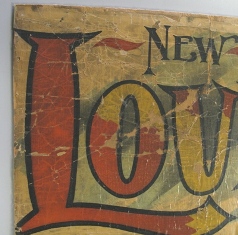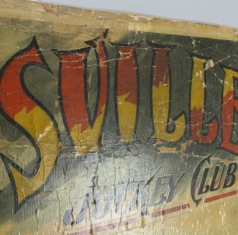By David Chandler, Chief Conservator of Works of Art on Paper
Before: New Louisville Jockey Club. Dimensions are approximately 7’ x 3.5’.
When the paper conservation staff here at The Center first encountered this massive and fragile poster, we immediately noticed that, along with water damage, the current housing was inappropriate for the longevity of the piece: The frame was an inadequate depth, and the sheet was in direct contact with a large and fragile piece of glass. Initially, due to the lack of spacers or mat, the poster appeared to be adhered to the glass which would have complicated matters greatly. Upon further examination, it was determined that a layer of discolored varnish on the surface of the piece was creating this illusion. In addition to the problem varnish, this work exhibited many areas of extremely tight distortion; these were the result of an earlier and unsuccessful effort to back the piece to fabric and mount it to a Masonite board.
(Above) Detail of distortion in raking light
(Above) Detail in raking light
Once unframed, the extent and severity of the condition problems the piece exhibited became readily apparent. The top of the poster, with its bold decorative title, was badly fractured with numerous losses required complex reconstruction. To complicate this situation, the top most passage was covered with a layer of coal dust. Ironically, the varnish layer seems to have in part protected some of the areas from the grime.
(Above) Detail of loss areas
Treatment Process
Poster and fabric back are carefully freed from the Masonite. The piece was then surface cleaned with brushes, erasers and eraser crumbles to remove grime and soil:
Varnish removal: using organic solvents – a complex procedure since some of the inks were more responsive to this step than others.
Facing tissue: the addition of a light weight Asian paper with a low tack synthetic adhesive to keep fragments in place during treatment:
Removal of old fabric backing: laborious removal of strips of the old backing to prepare the poster for water cleansing:
Water cleansing to remove degradation and adhesive removal are both a laborious and complex process. There were numerous times when the size of this work dictated the number of conservators needed to successfully manipulate it:
Lining paper – a heavy weight Asian lining paper was chosen to help stabilize the poster. Lining preparation involved the spray moistening and paste application for the large lining paper to make it flat on the Mylar corners:
Drying the work required the creation of a large cotton blotter “sandwich” to pull moisture away from the newly backed poster. Blotter changes helped to make the poster flat since the drying process involves many weights on the Plexiglas cover. Drying time is often more than one week:
Many hours of reconstruction and retouching were required to make the image unified once again:
The success of the treatment is easily seen in the tonal shift of the paper color. This makes the printed colors much easier to see and enjoy. The absence of the yellowed varnish is also a principle reason for the renewed appearance of the paper. The reduction of the distortion in this monumental print makes it so much more enjoyable to view.
Final thought: Take note of the smiling horses out in front moving to the finish line.
The treatment was expertly carried out by Olga Knopf, Senior Conservator of Works on Paper; and Brian Kapernekas, Associate Conservator of Works on Paper. Ryan Butterfield, Director of Custom Framing and Fabrication, assisted when extra hands were required.

















